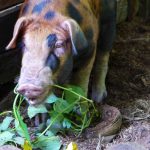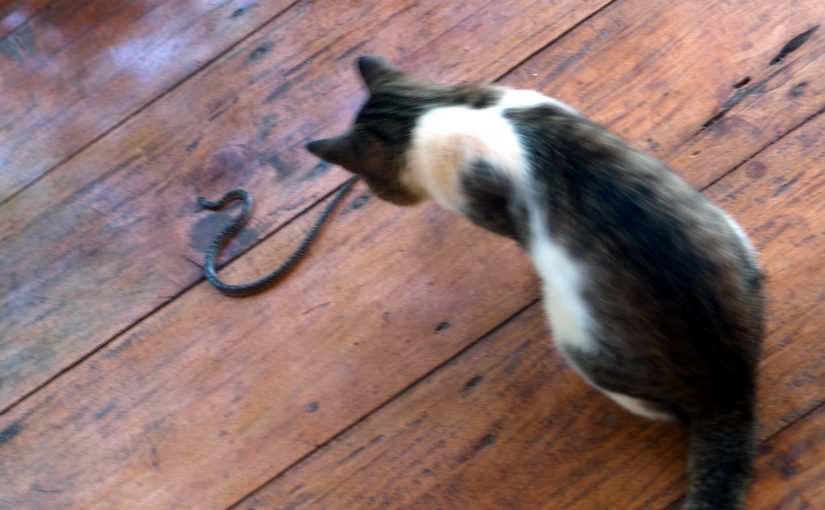Having ponds for rainwater harvesting, lots of frogs and toads are attracted to the garden. This is good because frogs are a sign of good ecology and they keep pesty insects under control. Here is a video of frogs spawning, one female and two males! The white foam is a nest in which the eggs are deposited. The foam nest protects the eggs from microbes and predators, to some extent – I have seen the turtle in the duck pond eating the frog eggs!
Category: Miscellany
Rainwater Harvesting
If you look around the village you will still see old water cisterns built many decades ago before running water became available in households. Some of these have been abandoned, broken but a few are still in good use. Rainwater harvesting is particularly crucial if you have livestock, crops and drought seasons, as well as failures by the municipal waterworks to provide continuous running water.

Currently, we have three ponds that harvest rainwater. The first (photo above) is home to some 30-40 tilapia and floating water plants. It is located next to the house on the south side catching a good amount of rainwater flowing off the edge of the roof. It’s about 146 cubic feet (or about 4 cubic meters). I keep two buckets under the overflow pipe to collect more rainwater during an overflow.

The second (photo above) is located on the north side of the house and has a volume of about 70 cubic feet (or 2 cubic meters). This is home to water hyacinth, water lettuce and frogs. We didn’t put fish in this pond because the fish kills the water hyacinth and water lettuce. The presence of frogs and tadpoles make sure there are no mosquito larvae in this pond. The water in this pond is used as drinking water for sow Number 3 who also loves eating the water lettuce.

The third water reservoir is this (photo above), the duck pond. Some water lettuce thrive here but not the water hyacinths which the ducks eat immediately. This pond becomes dirty (build up of mud, organic material, algal blooms) when the duck population is high – that is, over a dozen ducks. This pond is not large enough for that many ducks. At the moment, I have only 8 ducks and it is the rainy season so the pond stays reasonably clean. The water plants also keep the water clean, preventing algal blooms. There are also 2 turtles in this pond, plus an impressive chorus of frogs and toads. These and the ducks ensure that mosquitoes do not thrive in this pond.

Rainwater from the first two ponds have been crucial during the Bohol (2013) and Leyte (2017) earthquakes which knocked down power supply to the island for several weeks. Without power, municipal water pumps are non-operational and cannot pump water to many households. We were able to use water harvested in these ponds for cleaning, for the animals to drink and for flushing.
Now we are seriously considering building another pond to harvest rainwater run-off from the roof of the new pigpens. This pond would be closer to the pigpens and would ease use. A rain garden nearby, where the ground slopes, might also be an excellent feature to catch water that overflows from the pond.

Cicada
At last, captured a cicada performing its famous ear-breaking song. 😉 This would most probably be a male cicada singing to attract a female. Most cicadas go through a life cycle lasting 2-5 years; there are others that have 13-17-year life cycles. Enjoy! 🙂
Wildlife @home
I couldn’t sleep, it was nearly 2am, I got up to visit the loo and lo and behold, the reason why there isn’t a single rat running up on the roof!
Update: A week later, one of our neighbours captured a python and placed it inside a plastic screen cage. They wanted to sell it to a zoo in Loay. As far as I know, this is illegal. The zoo refused to buy it and instead instructed them to return it to the wild. However, the people who captured it were too scared to set it free, so they left the python in the cage on an empty lot near our home. I found this very upsetting – they left that snake to die. I emailed the DENR and asked them to come immediately to get the python and release it into its appropriate habitat. The next day, they arrived!
Introducing Bootleg
A couple of weeks ago I made this simple video of my dear boar, Bootleg. This introduces Bootleg’s story, which I will write about in greater detail later. In the meantime, I hope you enjoy! ❤️

























